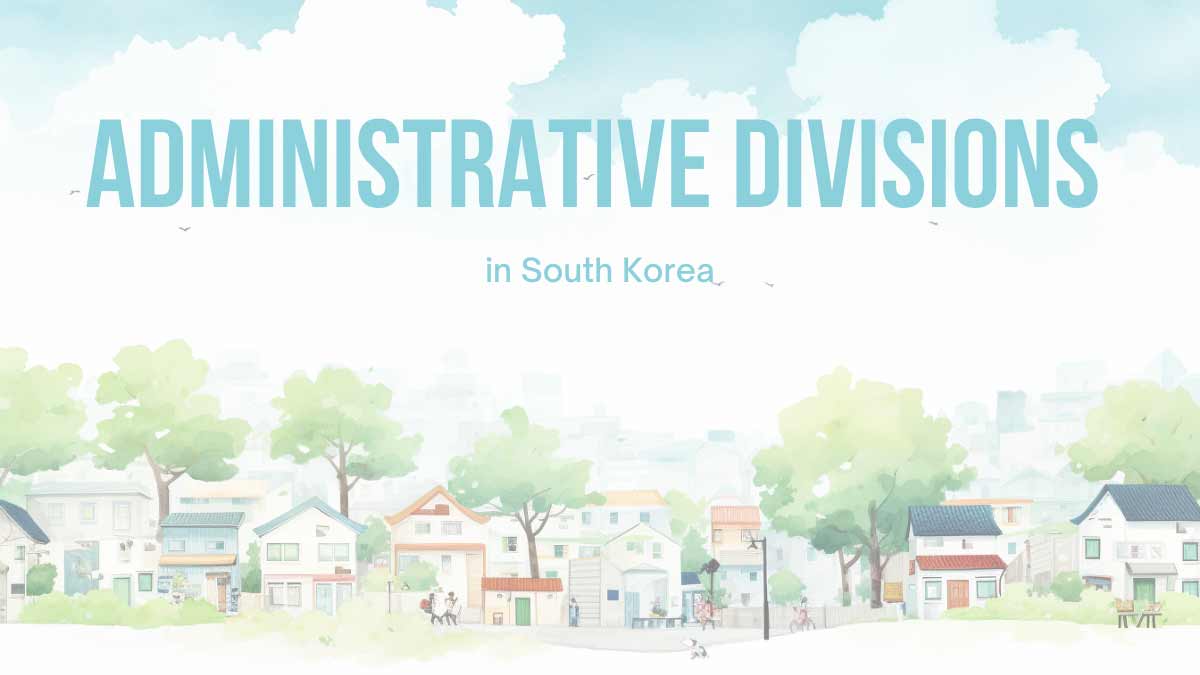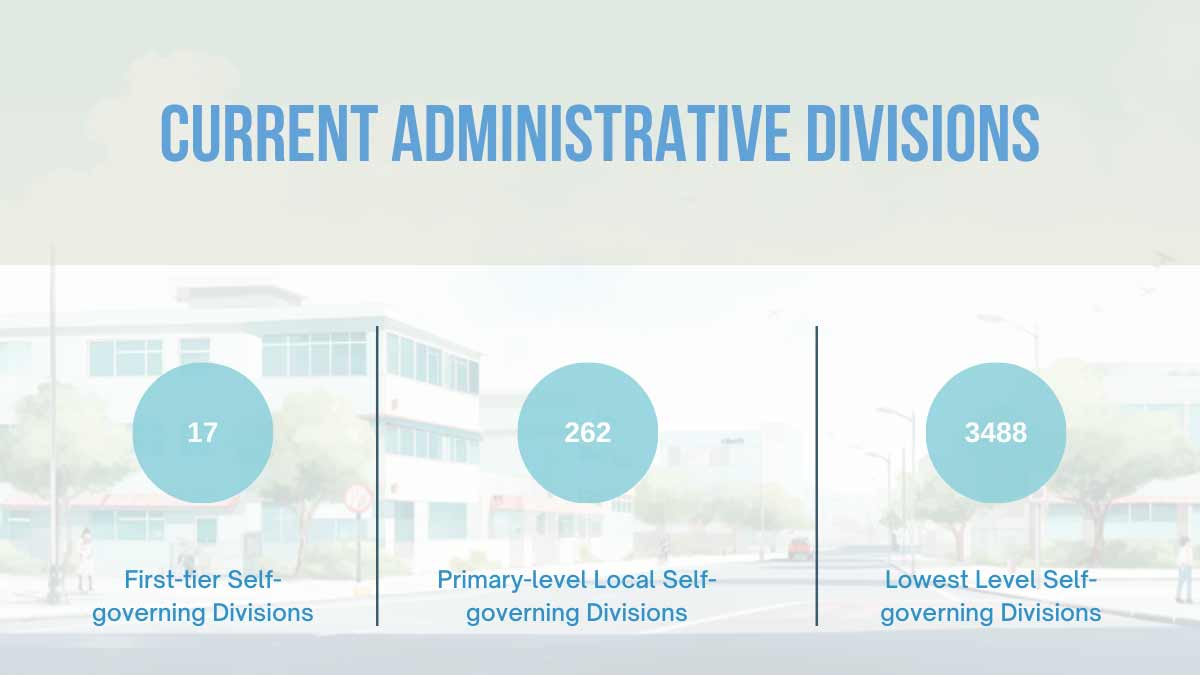Administrative districts in Korea serve as essential units for local governance while also contributing to the establishment of regional and local identities. Since the country's inception, Korea has undergone several administrative reorganizations aimed at enhancing administrative efficiency. The administrative district system of the Joseon Dynasty, which was province-oriented or -do-based, forms the foundation of the modern metropolitan administrative system in Korea.

The History of South Korea Administrative District
In 1945, the administrative system on the Korean Peninsula consisted of one special city, 15 provinces (-do), 23 cities (-bu), and 208 counties (-gun). Subsequently, Jeju Island was separated from Jeollanam-do to become Jeju-do, an independent province. In 1948, -bu was replaced with -si.
In 1962, the South Korean government implemented comprehensive reforms to align living spaces with administrative districts. Small towns were elevated to city status as their populations increased, while major cities were designated as directly-controlled municipalities to enable direct management by the central government. In the 1980s, large provincial cities such as Incheon, Daegu, Gwangju, and Daejeon were elevated to directly-controlled city status.
In 1995, a comprehensive provincial administrative reform was undertaken to address various objectives. This restructuring aimed to integrate cities and counties, balance development between growing urban areas and declining rural regions, secure land for urban development, enhance administrative efficiency, and resolve discrepancies between daily life spaces and administrative districts. As part of this reform, directly-controlled municipalities were reorganized into metropolitan cities by merging neighboring areas. Consequently, 40 urban/rural integration cities were established, and five metropolitan cities—Busan, Daegu, Incheon, Gwangju, and Daejeon—were created. Ulsan was later elevated to metropolitan city status in 1997.
In the early 2000s, a series of mergers between cities and counties occurred, and Jeju Island attained the status of Jeju Special Self-Governing Province. Additionally, Sejong, a multifunctional administrative city, was designated as the Sejong Metropolitan Autonomous City in 2012. As of January 1, 2014, the administrative system in the Republic of Korea comprised one special city (Seoul), six metropolitan cities, one special autonomous city, eight provinces, and one special self-governing autonomous province.

Understanding the Administrative District of South Korea
- Metropolitan Cities
- Self-Governing Bodies
Despite their smaller geographic areas compared to provinces, hold significant importance in the administrative system. This prominence can be attributed to their population, as some metropolitan cities have larger populations than certain provinces. Places with concentrated populations require special attention and legislation to address their unique needs.
In Korea, the key entity responsible for local autonomy is the administrative organization closely connected with local residents. The self-governing body consists of local residents and forms a distinct legal entity. Two types of self-governing bodies exist in Korea: macro-level bodies such as Special City, Metropolitan City, Special Autonomous City, -do (province), or Special Autonomous Province, and primary level bodies such as -si (city), -gun (county), or -gu (district). Local residents participate in the autonomy of their local government primarily through elections.
Local autonomy refers to the political and administrative decision-making carried out by self-governing bodies representing residents within a specific regional boundary. In the current global era, the demand for enhancing regional competitiveness, promoting inter-regional development equity, and providing resident-oriented administrative services has amplified the need for local autonomy. This global trend primarily entails granting autonomous power over local affairs and independent budgetary capacity to a geographical region that houses residents and a self-governing body.
Empowered Decision-Making and Governance
The establishment of local councils in 1991 marked the advent of the era of local autonomy in Korea after 30 years of preparation. Since then, the scope of local affairs and local authority has continued to expand. Key aspects of local autonomy include jurisdiction; organization and administrative management of local government; promotion of residents' welfare; development of industries, including agriculture, forestry, trade, and factories; local development initiatives; establishment and management of public and private facilities for residents; promotion of education, athletics, culture, and art; public safety; and firefighting.
As of 2014, the first-level self-governing bodies in Korea consist of Seoul Special City, six Metropolitan Cities (Busan, Daegu, Incheon, Gwangju, Daejeon, and Ulsan), Sejong Special Autonomous City, eight provinces (-do), and Jeju Special Autonomous Province. Additionally, there are 262 primary-level self-governing bodies, including 77 cities (-si) (including two non-autonomous cities), 83 counties (-gun), and 102 districts (-gu) (including 33 non-autonomous districts). Moreover, there are 216 towns (-eup), 1,196 townships (-myeon), and 2,076 neighborhoods (-dong), which form the lowest level of area subdivisions. Together, these self-governing bodies constitute the localized administrative system in Korea. And still in use today.

A Complex Landscape of Governance
The administrative district system in Korea has evolved over time, reflecting the changing needs of governance and the aspirations of local communities. From the province-oriented administrative system of the Joseon Dynasty to the comprehensive reforms and mergers of cities and counties, Korea has strived to achieve administrative efficiency, balanced development, and enhanced local autonomy. Metropolitan cities have emerged as significant units in the administrative structure, catering to the specific needs of densely populated areas. The concept of local autonomy has gained momentum, empowering self-governing bodies to make decisions and manage local affairs. With an evolving administrative landscape, Korea continues to adapt to meet the challenges and aspirations of its regions and residents.